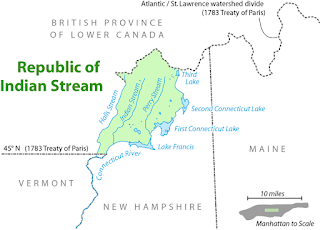The Republic of Indian Stream or Indian Stream Republic was an unrecognized constitutional republic in North America, along the section of the border that divides the Canadian province of Quebec from the U.S. state of New Hampshire. It existed from July 9, 1832, to August 5, 1835. Described as "Indian Stream Territory, so-called" by the United States census-taker in 1830, the area was named for Indian Stream, a small watercourse. It had an organized elected government and constitution and served about three hundred citizens.
The area was first settled by Europeans under a land grant, not from the King of Great Britain, but from the St. Francis Indian chief, called King Philip by his white neighbors, after the King Philip who had led many successful raids on New England settlements during the 1670s. I believe the first Dowgin came during that time to be killed in the King Phillip War.
Also, the establishment of Indian Stream as an independent nation was, essentially, the result of the ambiguous boundary between the United States and Canada as defined in the 1783 Treaty of Paris. There were three possible interpretations of where "the northwesternmost head of the Connecticut River" might be. As a result, the area (in and around the three tributaries that fed into the head of the Connecticut River) was not definitively under the jurisdiction of either the United States or Canada.
Both sides sent in tax-collectors and debt-collecting sheriffs. The double taxation angered the population, and the Republic was formed to put an end to the issue until such time as the United States and Great Britain could reach a settlement on the boundary line. Some of the citizenry considered Indian Stream to be part of the U.S. but not a part of New Hampshire. The Indian Stream assembly declared independence on July 9, 1832, and produced a constitution. So you see why my parents were confused...
The Constitution of Indian Stream states in "Part Second - Form of Government":
- "The people inhabiting the Territory formerly called Indian Stream Territory do hereby solemnly and mutually agree with each other to form themselves into a body politic by the name of Indian Stream and in that capacity to exercise all the powers of a free, sovereign and independent state, so far as it relates to our own internal Government till such time as we can ascertain to what government we properly belong."
The annexation of Indian Stream by New Hampshire did not resolve the land dispute, however. Local British officials took a dim view of the annexation. An incident soon tested the situation. In October 1835, Blanchard led a small party to arrest John Tyler for an unpaid hardware-store debt. After the arrest, Tyler was freed on the road back to Coos County by a group of his neighbors. In reporting the incident to the British magistrate, Tyler falsely stated under oath that the location of his arrest was Drayton, Lower Canada. The magistrate then issued a warrant for Blanchard's arrest, which was carried out by a deputy and a few members of the Canadian faction of Streamers, who returned with Blanchard toward the magistrate's house in Lower Canada.
Along the way, a group of Streamers stopped them in the road, rescued Blanchard and returned with their freed comrade to Indian Stream. The deputy's party continued on to the magistrate's house. Several hours later, there was a commotion in the road nearby from a posse of armed Streamers, emboldened by liquor, bent on making an impression. The invading posse shot the deputy through the thigh and then captured the hobbled magistrate with a blow of a saber to his scalp during a struggle. They returned to Canaan, Vermont, with the bleeding magistrate as prisoner, where local leaders treated his wound and released him immediately. In the aftermath, a detachment of fifty New Hampshire militia, including troops and officers, occupied the territory from mid-November until February 18, 1836.
This international incident caused a diplomatic crisis. The British ambassador to the United States protested to President Jackson and the Secretary of State. Both governments, appalled at the idea of war over a matter so trivial as a hardware-store debt, determined to take measures so that matters did not escalate, and an uneasy peace endured in the years preceding the conclusion of a treaty settling the border.
In July, 1837, Lord Palmerston in London dismissed all charges in the British judiciary system arising from the incident and reiterated the British position that the territory was part of Canada. The area was still described as Indian Stream at the time of the U.S. census taken on June 1, 1840; the local population totaled 315. Upon petition by the residents, the area was incorporated as the town of Pittsburg in 1840.
In 1842, the land dispute was definitively resolved by the Webster–Ashburton Treaty, and the land was assigned to New Hampshire. However, the 1845 Lewis Robinson Map of New Hampshire based on the latest authorities, shows the boundary north of the town of Clarksville but just south of modern-day Pittsburg.
This reminds me of some Marx Brother movie. Geez...
~Tyler
To find out more about Tyler visit Salem House Press and buy Tyler's latest book "Tyler Moves to Gibsonton Florida" on Amazon.com. Keep checking back often for great cheap vacation ideas that might end up surprising you and becoming the best vacation you ever had!

No comments:
Post a Comment